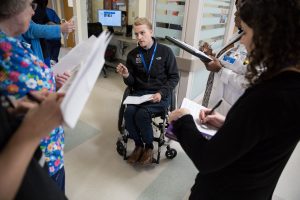Even though it’s been 27 years since the signing of the Americans with Disability Act, people with disabilities still don’t have equal access to accessible healthcare. People with disabilities tend to be in poorer health and to use health care at a significantly higher rate than people who do not have disabilities. They also experience a higher prevalence of secondary conditions and use preventive services, such as cancer screenings and dental exams, at a lower rate than others. People with disabilities a have higher rates of unaddressed cardiovascular risk factors like obesity, smoking and hypertension.
 According to the National Council on Disability, this is the result of barriers to care, which people with disabilities are disproportionately affected by. The wide range of barriers, which include health care provider misinformation, and stereotypes about disability, to lapses in insurance coverage and inadequate transportation, makes this issue a complex problem to solve.
According to the National Council on Disability, this is the result of barriers to care, which people with disabilities are disproportionately affected by. The wide range of barriers, which include health care provider misinformation, and stereotypes about disability, to lapses in insurance coverage and inadequate transportation, makes this issue a complex problem to solve.
A recent New York Times article argues that a new approach needs to be taken on this issue, which traditionally would be addressed by greater attention in medical school curriculums. Having a more diverse workforce – one that includes doctors with disabilities – could be the solution.
Out of the 50 million people living with disabilities, only two percent are practicing physicians and the majority acquire them after medical school. This is due in part to the fact that few people with disabilities are admitted to medical school, and once admitted, have higher attrition rates than able-bodied students because they don’t always receive the support they need.
Dr. Gregory Snyder, a physician at Brigham and Women’s Hospital in Boston, became one of the two-percent after an accident in medical school, which resulted in paraplegia. Since so few doctors make their rounds using a wheelchair, he is often mistaken for a patient, which he sees positively. “It reminds us that at some point we’ll all be patients,” he said. “And perhaps, when we least expect it.”
Dr. Snyder also believes that his spinal cord injury has changed the way he treats his patients. He knows firsthand the experience of being a patient and having a disability, which can’t be taught in medical school.
“I would have been this six-foot-tall, blond-haired, blue-eyed Caucasian doctor standing at the foot of the bed in a white coat,” he said. “Now I’m a guy in a wheelchair sitting right next to my patients. They know I’ve been in that bed just like they have. And I think that means something.”
Having mentors and colleagues with disabilities in the medical field could foster understanding of different abilities and perspectives, and create an environment that challenges negative biases about those groups is an interesting argument. What do you think? Please comment below.
Click here to read entire story in the New York Times
This is so true, & even more horrendous for us quadriplegic patients. I have had horrible experiences trying to oybtain a mamogram, breast MRI, colonoscopy & full body skin check at a dermatologist’s office. All were pre-researched by my doctor & claimed this or that accommodation would be made. The 1st mammogram attempt left me with 3 skin breaks (physical abuse) and the phrase “we do YOUR kind of people all the time” ringing in my ears. They certainly did NOT understand the difference between paraplegic and quadriplegic. The simplest problem is dressing/ undressing. Bringing an aide to help is not enough. Exam tables do not allow for safe rolling reqired to get pants/skirts back on. Unfortunately, female SCI patients I know above age 50 or so simply do not even try to get these “routine” tests.